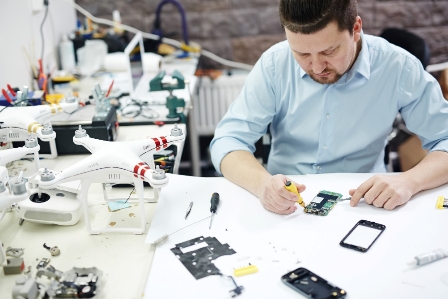In the intricate world of service repair, technology has emerged as a game-changer. As we delve into the evolving landscape, it becomes evident that the role of technology in modern service repair is not just about fixing issues but revolutionizing the entire process.
Importance of Service Repair
Service repair is the backbone of various industries, ensuring the continuous functionality of equipment and systems. It plays a pivotal role in minimizing downtime and maintaining the smooth operation of businesses.
Impact of Technology on Service Repair
The integration of technology has significantly transformed the way service repair is approached. From traditional manual methods to sophisticated technological solutions, the journey has been nothing short of remarkable.
Evolution of Service Repair
Traditional Methods
Historically, service repair relied heavily on manual inspection and troubleshooting. Technicians followed conventional practices, often leading to delays and inefficiencies.
Shift towards Technology
In recent years, there has been a paradigm shift towards technology-driven service repair. Businesses have embraced innovative solutions to enhance efficiency and stay ahead in a competitive market.
Role of Technology in Modern Service Repair
Automation and Efficiency
Automation has streamlined service repair processes, reducing the time required for diagnostics and repairs. Automated systems can quickly identify issues, allowing technicians to focus on solutions rather than spending excessive time on problem identification.
Diagnostic Tools
Technological advancements have brought forth sophisticated diagnostic tools that enable precise identification of problems. These tools not only save time but also contribute to accurate and effective solutions.
Remote Monitoring
The ability to monitor equipment remotely has revolutionized service repair. Companies can now keep a vigilant eye on their systems, proactively addressing issues before they escalate, leading to enhanced reliability.
Predictive Maintenance
Predictive maintenance, powered by technology, has taken service repair to a proactive level. By analyzing data and predicting potential failures, businesses can schedule maintenance activities strategically, minimizing disruptions.
Innovations in Service Repair
Augmented Reality (AR)
AR has transformed the way technicians visualize and interact with equipment. It provides real-time overlays of information, guiding technicians through complex repair processes with precision.
Artificial Intelligence (AI)
AI algorithms can analyze vast amounts of data, identifying patterns and predicting potential failures. This not only saves time but also reduces the likelihood of unexpected breakdowns.
Internet of Things (IoT)
The IoT connects devices and systems, enabling seamless communication. In service repair, IoT facilitates real-time data exchange, creating a connected ecosystem that improves overall efficiency.
Blockchain in Service Repair
Blockchain ensures the integrity and transparency of data in service repair. It provides a secure and unalterable record of maintenance activities, instilling trust in the service repair process.
Benefits of Technological Integration
Increased Efficiency
The incorporation of technology has led to a significant increase in repair efficiency. Quick diagnostics, precise solutions, and streamlined processes contribute to a more efficient service repair ecosystem.
Cost Reduction
While the initial investment in technology may seem significant, the long-term benefits include cost reduction. Predictive maintenance and efficient repair processes lead to lower operational costs and minimized downtime.
Enhanced Customer Experience
Customers benefit from faster and more reliable service repair, contributing to an overall enhanced experience. The integration of technology ensures that businesses can meet customer expectations in a dynamic and competitive market.
Challenges and Solutions
Technological Adaptation Challenges
One challenge faced by businesses is the adaptation to new technologies. Training employees and ensuring a smooth transition is crucial. Comprehensive training programs and continuous support can overcome this hurdle.
Training and Skill Development
As technology evolves, so should the skills of service repair technicians. Investing in ongoing training and skill development programs is essential to keep the workforce updated and proficient in handling advanced technologies.
Cybersecurity Concerns
The increased reliance on digital systems brings forth cybersecurity concerns. Implementing robust cybersecurity measures and staying informed about potential threats are imperative to safeguarding sensitive data.
Future Trends
Integration of Advanced Technologies
The future of service repair will witness a deeper integration of advanced technologies. Machine learning, robotics, and further advancements in AI will continue to shape the landscape of service repair.
Sustainability in Service Repair
Sustainability will become a key focus in service repair. Technologies that contribute to energy efficiency and eco-friendly practices will gain prominence, aligning with global efforts towards a sustainable future.
The Human Touch in Modern Service Repair
Balancing Technology and Human Expertise
While technology is transformative, the human touch remains indispensable. Balancing the efficiency of technology with the expertise and empathy of human technicians ensures a comprehensive and customer-centric service repair experience.
Customer Interaction
Maintaining direct and transparent communication with customers throughout the repair process is crucial. Technology should enhance, not replace, the personal touch in customer interactions.
FAQs
Predictive maintenance analyzes data to predict potential equipment failures, allowing businesses to schedule maintenance proactively. This not only minimizes downtime but also contributes to the overall efficiency of service repair.
Businesses may encounter challenges in technological adaptation, employee training, and cybersecurity. Overcoming these hurdles requires comprehensive training programs, continuous support, and robust cybersecurity measures.
Technology improves service repair by providing faster diagnostics, precise solutions, and real-time communication. This contributes to an enhanced customer experience through reliable and efficient service.
While technology is crucial for efficiency, the human touch ensures empathy, expertise, and personalized interactions with customers. Balancing technology with human expertise is key to a comprehensive service repair experience.
The future of service repair will witness deeper integration of advanced technologies such as machine learning, robotics, and a focus on sustainability. These trends aim to enhance efficiency while aligning with global efforts for a more sustainable future.
Conclusion
The role of technology in modern service repair is paramount. From automation and diagnostics to the integration of AR, AI, and IoT, technological innovations have reshaped the landscape, bringing about increased efficiency, cost reduction, and an enhanced customer experience. While challenges exist, proactive solutions, continuous training, and a focus on cybersecurity can mitigate potential issues. As we move forward, the marriage of advanced technologies and the human touch will define the future of service repair, ensuring a seamless and customer-centric approach.


